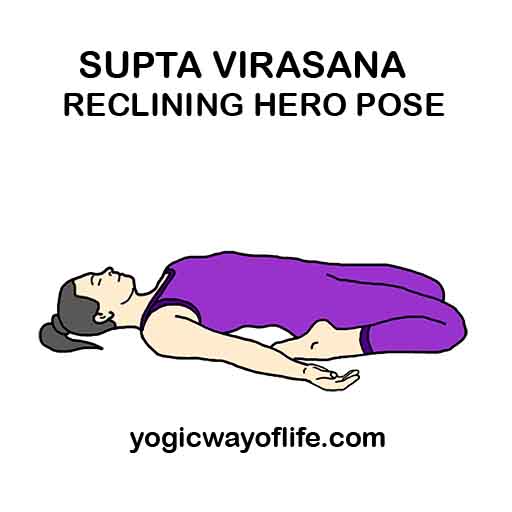Supta Virasana or the Reclining Hero Pose is a variation of Virasana or the Hero’s pose. The starting position for Supta Virasana is same as Virasana, but the final position looks very different. Also, this pose is similar to Supta Vajrasana, yet different in the way the legs are placed. In this asana, the legs and feet are placed on the side of the thighs, instead of under it.
Supta Virasana improves flexibility of the hips and lower back and enhances the power of digestion.

How to do Supta Virasana?
- Start with sitting on the floor with legs spread out.
- Bend the legs and come to the kneeling position. Spread the legs to the sides of the thighs with the feet resting next to the buttocks. This basic pose is called Virasana, the Hero’s pose. In this pose, the knees are kept close together, legs bent and buttocks resting on the floor with the legs and feet outside the thighs on the side.
- Once the Virasana position is taken, slowly bend backwards, supporting the body weight using your arms and elbows, till the back of the head touches the ground.
- Let the back rest on the ground firmly and rest the hands on the floor next to the thighs. The palms can be kept facing upwards on the floor besides the feet.
- Breathe normally and deeply in a rhythmic manner.
- Close the eyes and relax all the muscles of the body.
- Remain in this position, as long as it is comfortable.
- While performing this asana, the thigh muscles are stressed and may cause pain in the initial stages, especially if they are stiff. With practice, as the thigh muscles become more flexible, the pain will go away.
- To release the pose, sit up using the support of your hands on the floor. Slowly release the legs and spread them out in front.
- Shavasana can be used as a resting pose after doing this asana.
Benefits of Supta Virasana
- Supta Virasana stretches the abdominal and thigh muscles.
- It improves digestion.
- This pose can strengthen the hip region and brings flexibility to the back, but those suffering from sacral pain should consult a doctor before attempting this.
- It brings flexibility to the lower back and hips.
- For women, it improves health of reproductive organs.
Variation of Supta Virasana
There are various variations of Supta Virasana where the placement of the hands is changed. In the most common variation, the hands are raised and placed under the head. This variation puts no pressure on the neck, but expands the chest and increases the pull on the abdominal muscles.
Contraindications of Supta Virasana
- This asana stretches the entire spine and puts pressure on the hips and sacral regions. Those suffering from sacral pain and other spinal defects should seek expert advice before attempting this asana.
- If you have any injury of the lower back or hips avoid this pose.
- This pose is an intermediate level pose. Perform other simpler asanas to gain flexibility of the knees and thighs. Attempt this pose only after improve flexibility of the knees and thighs.
